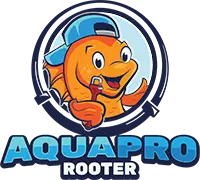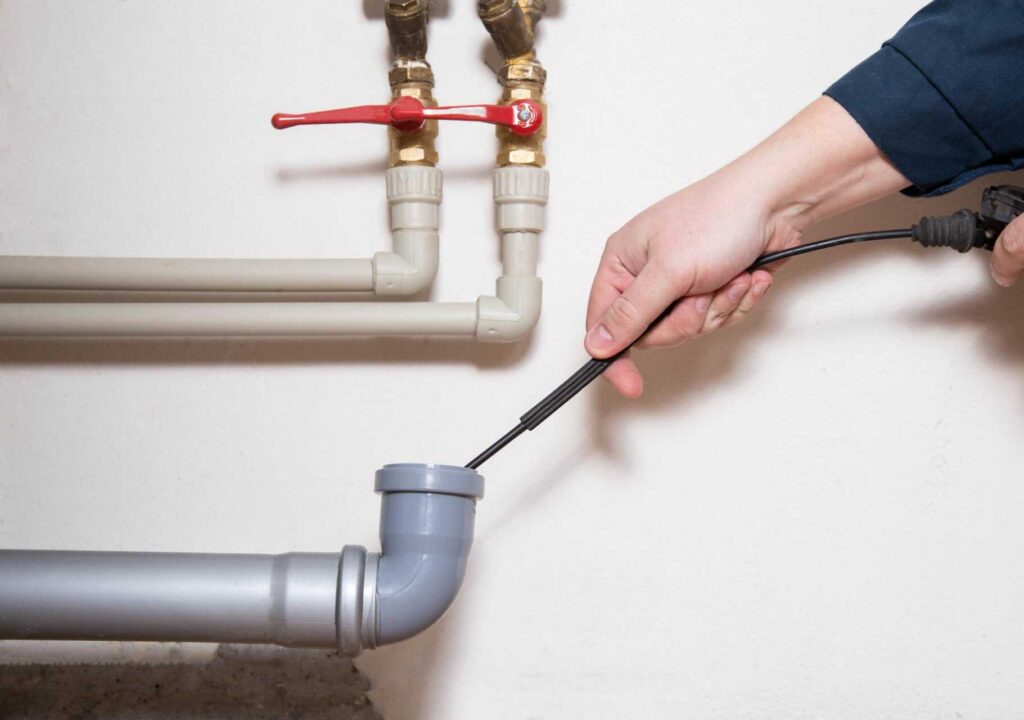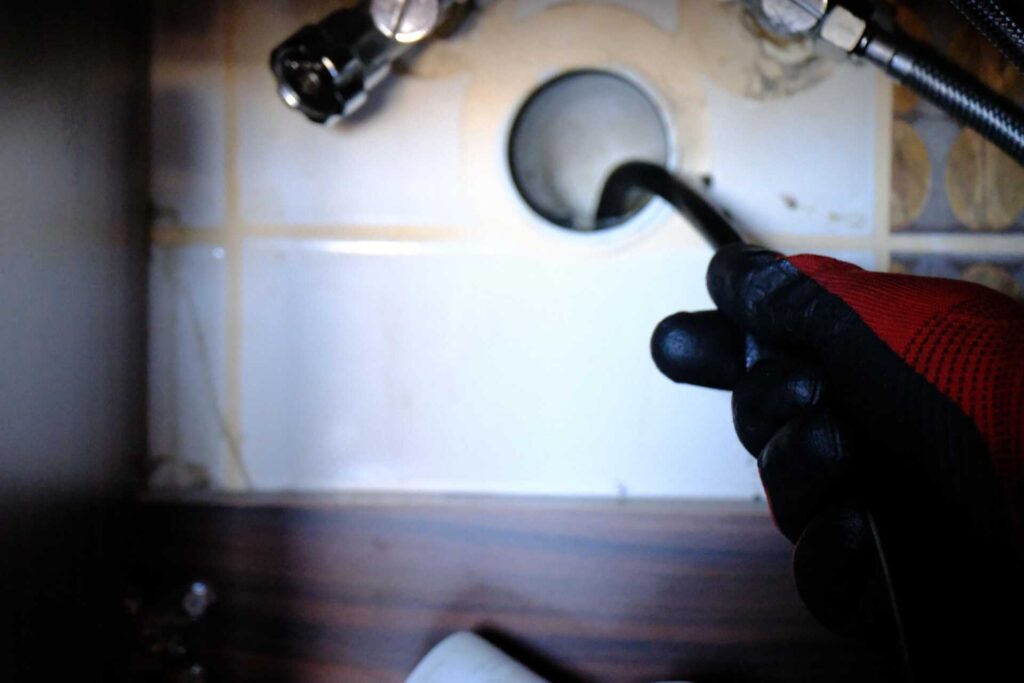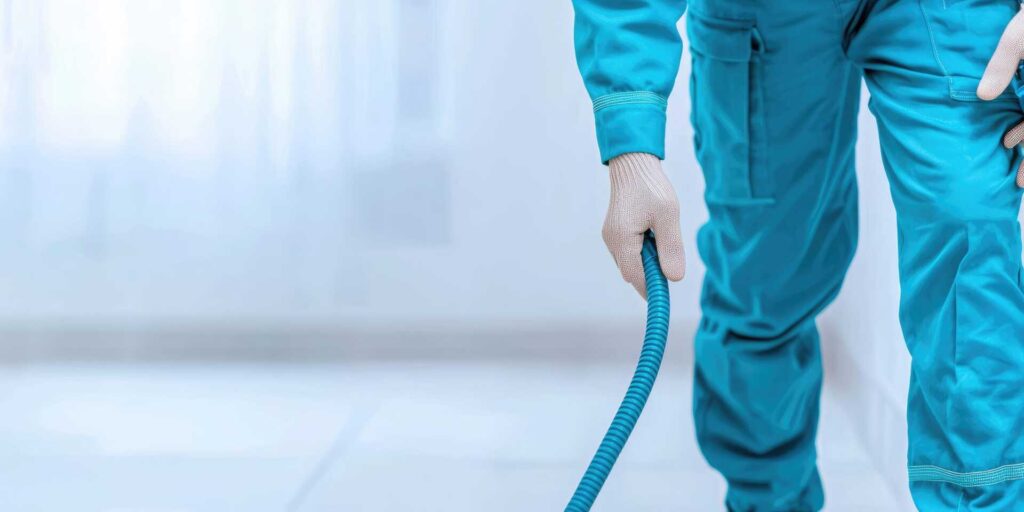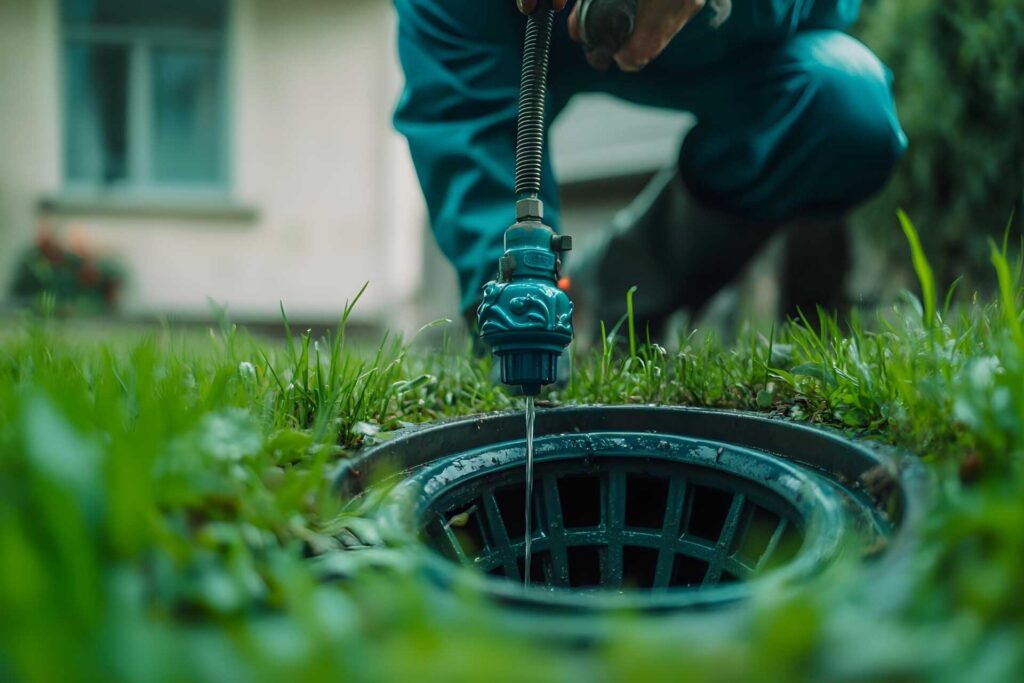
Contents
Imagine your neighbor’s home suddenly flooding due to a stubborn clog that traditional methods failed to clear. You might wonder how hydro jetting could have prevented such a mess. This powerful technique uses high-pressure water to dislodge blockages and clean the entire pipe system, promoting long-term health for your plumbing. But before you consider this solution, it’s crucial to understand the benefits and process involved. What exactly makes hydro jetting a superior choice for managing clogged drains?
Key Takeaways
- Hydro jetting uses high-pressure water to effectively clear stubborn clogs, grease, and debris in drains and sewer lines.
- The process includes a video inspection to identify specific plumbing issues before applying tailored hydro jetting techniques.
- Regular hydro jetting serves as preventive maintenance, reducing future blockages and eliminating bacteria associated with sludge buildup.
- It is a safer and environmentally friendly alternative to chemical treatments, minimizing health risks and exposure to harsh substances.
- Investing in hydro jetting can save money long-term by preventing recurring plumbing issues caused by traditional methods.
What Is Hydro Jetting?
Hydro jetting is a powerful plumbing technique that uses high-pressure water to clear stubborn clogs and blockages in drains and sewer lines. This method relies on specialized equipment that generates a focused, high-velocity stream of water, effectively dislodging debris, grease, and other obstacles that traditional methods might leave behind. When you consider the efficiency of hydro jetting techniques, it becomes clear why many homeowners and professionals prefer it for thorough drain cleaning.
Unlike standard drain cleaning technologies, which often involve snakes or chemical solutions, hydro jetting provides a clean slate for your plumbing system. The high-pressure water clears existing clogs and prevents future buildup by scouring the pipe walls. This extensive cleaning action can extend the lifespan of your plumbing system, making it a valuable investment for both residential and commercial properties.
When you hire a professional for hydro jetting, they’ll first conduct a video inspection of your pipes to identify the specific issues. This ensures that the hydro jetting process targets the problem areas effectively. You’ll appreciate the peace of mind that comes with knowing your plumbing system is in good hands. By understanding the mechanics of hydro jetting, you’re better equipped to make informed decisions regarding your home’s plumbing needs. Embracing this advanced technique means you’re taking proactive steps to maintain a healthy and efficient drainage system, fostering a sense of belonging within your community of informed homeowners.
Benefits of Hydro Jetting
When it comes to maintaining a clear and efficient plumbing system, the benefits of hydro jetting are substantial. This method clears stubborn clogs and improves the overall health of your plumbing. Here are some key advantages you can expect:
| Benefit | Description | Environmental Impact |
|---|---|---|
| Efficient Cleaning | Hydro jetting removes buildup, grease, and debris. | Reduces need for chemicals. |
| Preventive Maintenance | Regular hydro jetting can prevent future blockages. | Minimizes waste generation. |
| Safety Considerations | High-pressure water is safer than chemical treatments. | Less chemical runoff. |
Hydro jetting offers significant environmental benefits. Instead of relying on harsh chemicals that can harm local ecosystems, this method uses just water, making it safer for both your plumbing and the planet. You can feel good knowing that you’re choosing a more sustainable option.
Safety considerations also play a crucial role in hydro jetting. Unlike chemical solutions that can pose risks to your health, this technique minimizes exposure to harmful substances. It’s a safer choice for you and your family, as well as for professional plumbers.
How Hydro Jetting Works
Clearing stubborn clogs is just the beginning; understanding how hydro jetting works can help you appreciate its effectiveness. Hydro jetting is a powerful plumbing technique that utilizes high-pressure water jets to clear blockages and restore flow in your pipes. By employing specialized equipment, professionals can direct streams of water at pressures ranging from 1,500 to 4,000 psi. This force can break apart tough materials like grease, tree roots, and mineral buildup, effectively eliminating the cause of your drainage issues.
The process starts with a thorough inspection of your plumbing system, often using a camera to identify the location and nature of the clog. After this assessment, technicians can choose the appropriate hydro jetting techniques tailored to your specific situation. They’ll then insert a nozzle into the affected pipe and initiate the water flow, utilizing pressure regulation to ensure that water is delivered precisely where it’s needed without damaging your plumbing.
As the high-pressure water jets blast through the clog, they clear the blockage and clean the pipe walls, preventing future buildup. This dual-action makes hydro jetting a long-lasting solution for your drainage problems. By understanding these techniques and the importance of pressure regulation, you can see why hydro jetting is a preferred method among professionals. It’s not just about clearing a path; it’s about maintaining the integrity of your plumbing system and keeping your home running smoothly.
Common Causes of Clogged Drains
Clogged drains can be a major inconvenience, and understanding the common causes can help you prevent future issues. While you might think it’s just a minor annoyance, knowing what creates blockages can save you time and money in the long run. Here are four common culprits behind clogged drains:
Kitchen Waste: Grease, food scraps, and cooking oils often find their way down your sink. These materials can solidify and accumulate, leading to significant blockages. Always use a strainer to catch food particles and dispose of grease properly.
Hair Accumulation: In bathroom drains, hair is a frequent offender. It mixes with soap and other debris, forming stubborn clumps that can easily obstruct flow. Regularly cleaning your drain covers can help minimize this issue.
Soap Residue: Many soaps and shampoos contain fats and oils that can build up over time. This residue can combine with hair and other debris, creating a thick barrier that restricts water flow. Opt for biodegradable soaps to reduce buildup.
Tree Roots: If you have trees near your plumbing lines, their roots may invade your pipes in search of water. This intrusion can cause significant damage and blockages. Regular inspections can help you identify potential root problems early on.
Signs You Need Hydro Jetting
If you’re experiencing frequent clogs, slow-draining water, or unpleasant odors from your drains, it’s time to contemplate hydro jetting. These signs indicate that there may be a significant buildup of debris or blockages in your plumbing system. Addressing these issues promptly can prevent more serious plumbing problems down the line.
Frequent Clogs Occurring
When you notice water draining slowly or repeatedly backing up in your sinks or tubs, it’s a clear indicator that your drainage system may require immediate attention. Frequent clogs typically signal underlying issues that need to be addressed in order to avoid more severe problems in the future. Here are some frequent causes you might encounter:
- Grease Buildup: Over time, grease can accumulate in your pipes, leading to blockages.
- Hair Accumulation: Hair strands in bathroom drains often combine with soap residue, forming stubborn clogs.
- Foreign Objects: Items that accidentally fall into drains can obstruct the flow.
- Tree Roots: Roots can infiltrate pipes, causing significant blockages and damage.
If you’re experiencing these frequent clogs, it’s crucial to contemplate preventative measures. Regular maintenance, such as cleaning your drains and being cautious about what goes down them, can help. However, if clogs persist, hydro jetting might be the ideal solution to clear away stubborn debris and restore your drainage system’s efficiency. Don’t wait for the problem to escalate; taking action now can save you from costly repairs later.
Slow Draining Water
Slow-draining water is a clear sign that your plumbing system is struggling to keep up with demand. When you notice slow water flow in your sinks, showers, or tubs, it’s often an indication of underlying drainage issues. These problems may arise from accumulated debris, grease buildup, or tree roots infiltrating your pipes. Ignoring these signs can lead to more severe blockages and costly repairs.
You might first notice the issue when water takes longer than usual to drain. If multiple fixtures are affected, the problem likely resides in your main sewer line. Slow-draining water disrupts your daily routine and can compromise your plumbing’s efficiency, leading to potential health hazards if left untreated.
Hydro jetting is an effective solution to tackle these drainage issues head-on. This process utilizes high-pressure water jets to clear away buildup and restore peak flow. If you’re experiencing slow water drainage, it’s time to evaluate hydro jetting as a proactive measure. By addressing these concerns now, you’ll ensure your plumbing system operates smoothly, keeping your home comfortable and functional.
Unpleasant Odors Present
Have you noticed unpleasant odors wafting from your drains? This is a sign that something isn’t right, and it often indicates the presence of odor sources like trapped food, grease, or stagnant water. These smells affect your home’s ambiance and signify a need for effective drain maintenance.
Here are four reasons to take into account hydro jetting for your clogged drains:
- Stubborn Blockages: If smells persist despite regular cleaning, hydro jetting can eliminate deep-seated clogs.
- Bacterial Growth: Odors may stem from bacteria thriving in sludge buildup. Hydro jetting removes this buildup effectively.
- Frequent Clogs: If you find yourself battling recurring blockages, it’s a clear signal that your drainage system needs professional attention.
- Aging Pipes: Older plumbing can accumulate debris over time. Hydro jetting refreshes the system, ensuring it operates smoothly.
Don’t ignore these unpleasant odors. Addressing them promptly with hydro jetting can restore freshness to your home and improve the efficiency of your drains. Your living space deserves to be odor-free and welcoming!
Hydro Jetting vs. Traditional Methods
When comparing hydro jetting to traditional methods, you’ll notice significant differences in cleaning efficiency and cost. Hydro jetting provides a more thorough clean, effectively removing stubborn blockages and buildup. On the other hand, traditional methods may save you money upfront, but often require more frequent maintenance and repairs.
Cleaning Efficiency Comparison
While traditional methods like snaking and chemical treatments can effectively clear minor clogs, hydro jetting offers a superior solution for more stubborn blockages. When considering cleaning techniques, hydro jetting stands out due to its high-pressure water jets that obliterate debris and buildup within pipes. Here’s how they compare:
- Thoroughness: Hydro jetting cleans the entire pipe surface, eliminating grease, scale, and roots, while snaking might only punch a hole through a clog.
- Longevity: Since hydro jetting removes the root cause of clogs, it helps prevent future issues, unlike chemical products that often provide temporary relief.
- Safety: Hydro jetting uses only water, making it an eco-friendly option. In contrast, chemical treatments can be harmful to both your plumbing and the environment.
- Versatility: Hydro jetting is effective for various pipe materials and sizes, whereas traditional methods may be less adaptable.
Cost Analysis Overview
Cost plays an essential role in deciding between hydro jetting and traditional drain cleaning methods. When evaluating your options, you’ll want to take into account various cost factors that impact your overall investment. Hydro jetting typically incurs higher initial costs than traditional methods, primarily due to the specialized equipment and technology involved. However, the long-term benefits can offset these expenses.
Traditional methods, such as snaking or chemical treatments, often seem more budget-friendly upfront. Yet, they may only provide temporary relief, leading to recurring issues that require additional services. This cycle can quickly add up, making hydro jetting a more cost-effective solution in the long run. You should weigh these budget considerations carefully, especially if you frequently experience clogs.
Moreover, hydro jetting can prevent future problems, reducing the likelihood of emergency repairs. This preventative aspect adds value, as it saves both time and money in the future. Ultimately, you’ll want to assess your unique situation, factoring in the extent of your drainage issues and your willingness to invest in a more permanent solution. By doing so, you can make an informed choice that benefits both your wallet and your plumbing system.
Choosing a Hydro Jetting Service
How do you choose the right hydro jetting service for your needs? Selecting a reliable service is essential to ensure that your clogged drains are addressed effectively. Here are some key factors to take into account:
Service Reputation: Look for a company with a solid reputation in the industry. A well-established service typically indicates reliability and expertise.
Customer Reviews: Check online reviews and testimonials. This feedback can provide insight into other customers’ experiences and help you gauge the quality of service you can expect.
Experience and Expertise: Evaluate how long the company has been in business and their level of expertise in hydro jetting. Experienced technicians are more likely to handle complex issues efficiently.
Licensing and Insurance: Confirm the service is properly licensed and insured. This protects you in case of any accidents or damage during the process.
The Hydro Jetting Process
In the hydro jetting process, specialized equipment plays an essential role in effectively clearing clogged drains. You’ll see high-pressure water jets that cut through blockages and restore flow. Understanding the steps involved can help you appreciate how this method works and why it’s so effective.
Equipment Used in Hydro Jetting
While the effectiveness of hydro jetting largely depends on the skill of the operator, the equipment used plays an important role in ensuring successful results. Understanding the key components of hydro jetting equipment can enhance your maintenance strategies and improve drain cleaning outcomes.
Hydro Jetting Machine: This powerful unit generates high-pressure water streams, typically ranging from 1,500 to 4,000 PSI, effectively breaking down tough clogs.
High Pressure Nozzles: These nozzles are essential for directing the water flow. Different nozzle designs, like rotating or piercing, target various types of blockages and pipe conditions.
Hoses: Durable hoses transport water from the machine to the nozzle. They’re designed to withstand high pressure and often come in various lengths to reach difficult areas.
Water Supply: A reliable water source is crucial. The hydro jetting process requires significant amounts of water to maintain consistent pressure and effectiveness.
Steps in the Hydro Jetting Process
The hydro jetting process involves several vital steps that ensure effective drain cleaning. First, you’ll need to conduct a thorough inspection of the drainage system using a camera to identify the blockage’s nature and location. This step is critical for determining the appropriate hydro jetting techniques to use.
Next, prepare the hydro jetting equipment, making sure it’s set up correctly and that you’ve selected the right nozzle for the job. The nozzle choice can greatly impact the hydro jetting benefits you’ll achieve, such as removing stubborn grease, tree roots, and mineral buildup.
Once everything is in place, you’ll insert the high-pressure hose into the drain, applying water at varying pressures to dislodge the blockage effectively. You’ll want to maintain a steady flow while moving the hose back and forth to ensure complete cleaning of the pipe walls.
After the blockage is cleared, performing a final inspection is vital to confirm the success of the hydro jetting process. This will help you maintain a clear drainage system and prevent future issues. With these steps, you can enjoy the full range of hydro jetting benefits, ensuring your drains remain clean and functional.
Maintaining Your Drains Post-Service
After your drains have undergone effective hydro jetting, implementing a regular maintenance routine is crucial for long-term performance. By following these drain maintenance tips, you can ensure your plumbing system remains clear and functional. Here are some preventive measures you should consider:
Regular Inspections: Schedule periodic inspections to identify potential issues before they escalate. Look for signs of slow drainage or unusual odors, which may indicate a problem.
Use Drain Screens: Install screens or guards over your drains to catch debris like hair and food particles. This simple step can noticeably reduce the risk of clogs.
Limit Grease Disposal: Avoid pouring grease down your drains, as it can solidify and create blockages. Instead, dispose of grease in a sealed container and throw it in the trash.
Routine Cleaning: Clean your drains regularly using a mixture of baking soda and vinegar. This natural solution can help break down minor build-up and keep your pipes flowing smoothly.
Cost of Hydro Jetting Services
Understanding the cost of hydro jetting services is vital for homeowners dealing with persistent drain issues. While the prospect of addressing clogged drains might seem intimidating, knowing the service pricing can help you make informed decisions. Hydro jetting is an effective solution, but the costs can vary based on several factors, including your location, the severity of the blockage, and the company you choose.
Here’s a quick breakdown of average service pricing:
| Service Type | Estimated Cost |
|---|---|
| Initial Inspection | $100 – $300 |
| Standard Hydro Jetting | $300 – $500 |
| Severe Blockage | $500 – $1,000 |
| Additional Services | $50 – $150 per hour |
When considering hydro jetting, it’s important to explore affordable options. Some companies offer package deals that can reduce overall costs, especially if you combine services like drain cleaning and maintenance. Additionally, asking for quotes from multiple providers can help ensure you’re getting a fair price.
Review
Hydro jetting is an effective solution for clogged drains that clears blockages and maintains the health of your plumbing system. As the saying goes, “an ounce of prevention is worth a pound of cure.” By investing in regular hydro jetting, you’re taking proactive steps to avoid future problems and ensure a fresher living environment. Don’t wait for clogs to disrupt your life—consider hydro jetting for a cleaner, more efficient drainage system.
